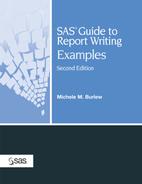Chapter 3. Summary Reports
A summary report summarizes observations in a data set. Summary reports can range from presentations of simple frequency counts to complex tables of descriptive statistics for categories defined by the combinations of several variables in the data set.
The examples in this chapter describe ways in which you can prepare summary reports. Each example presents a different style of summary report. Three procedures—REPORT, TABULATE, and MEANS—create the summary reports in this chapter. All examples use PROC FORMAT to assign labels to categories or to group categories. One example focuses on a special feature of PROC FORMAT that assigns multiple labels to categories.
All examples in this chapter send output to the default LISTING destination. Examples 3.2, 3.3, 3.5, 3.8 and 3.10 are modified in Chapter 6 to include ODS features and send the output to nonlisting destinations.
See the back of this book for a list of titles related to the features of these examples, and visit the SAS Press Web site (support.sas.com/saspress) for current information on new and revised publications.
Several presentations at SUGI conferences show how SAS users apply report-writing techniques. Recent conference proceedings that are available online provide a wealth of additional applications and examples. You can link to them through the SAS support Web site (support.sas.com).
Table 3.0 presents a cross-reference of the examples in this chapter to the procedures used, data sets used, and ODS enhanced versions of the examples. See Appendix A for details on the example data sets analyzed in this chapter. See Appendix B for a table that cross-references all examples in this book.
| Example | Report-Writing Tool Used | ODS Enhanced Version | Data Set | Example Title | |||||
|---|---|---|---|---|---|---|---|---|---|
| REPORT | TABULATE | DATA Step | MEANS | FREQ | |||||
| 3.1 | X | Related Technique | PHONDATA | Summarizing Data | |||||
| 3.2 | Related Technique | X | 6.5, 6.15 | BREAD | Computing Descriptive Statistics for Specific Groups | ||||
| 3.3 | Related Technique | X | 6.8, 6.9 | LIPIDS | Displaying Descriptive Statistics in a Tabular Format | ||||
| 3.4 | X | Related Technique | JOBCLASS | Displaying Basic Frequency Counts and Percentages | |||||
| 3.5 | X | 6.3, 6.7 | JOBCLASS | Producing a Hierarchical Tabular Report | |||||
| 3.6 | X | JOBCLASS | Creating Multipage Summary Tables | ||||||
| 3.7 | X | LIBRARIES | Assigning Multiple Labels to Categories | ||||||
| 3.8 | X | 6.2, 6.6 | CARSALES | Writing Customized Lines in Summary Reports | |||||
| 3.9 | Related Technique | X | TOWNSURVEY | Reporting on Multiple-Choice Survey Data | |||||
| 3.10 | X | 6.13, 6.14 | CUSTRESP | Reporting on Multiple-Response Survey Data | |||||
